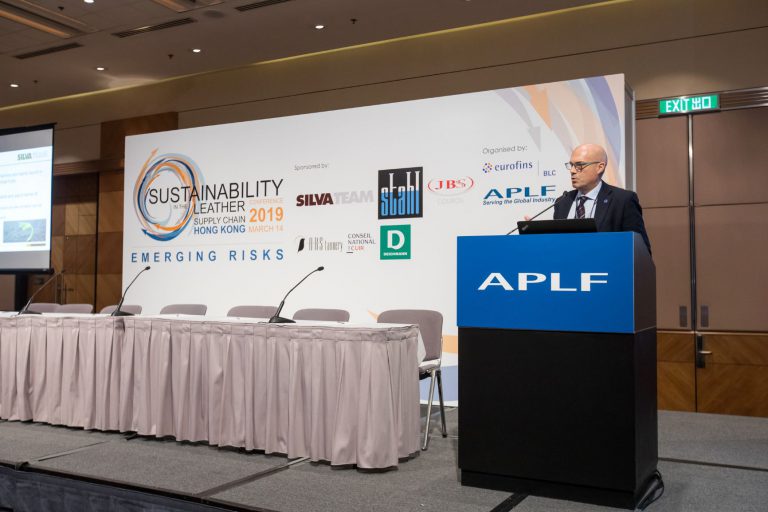25 March 2019

Sustainability in the Leather Supply Chain
In today’s landscape, the leather sector is open to new and evolving risks, which are increasingly scrutinising the sustainability of global leather production. Brands, retailers, manufacturers and tanneries are under pressure from consumers and NGOs to deliver a cleaner, more efficient and more sustainable leather industry. Opportunity for this arises from innovation and sustainable solutions, which were discussed on 14th March 2019 at the Sustainability in the Leather Supply Chain Conference 2019 in Hong Kong, sponsored by Silvateam, Stahl, JBS Couros, ARS Tannery, Deichmann and Conseil National du Cuir.
Eurofins | BLC and APLF hosted the industry leading conference, now in its 15th year, and welcomed over 100 delegates from around the world with some delegates travelling from as far as Brazil and the USA to attend. Delegates included sustainability professionals from global brands, retailers and leather manufacturers.
Peter Hughes, Sustainability Lead at Eurofins | BLC opened the conference, describing the emerging risks to the sector which included increasingly stringent legislation for controlling chemistry and how consumer perceptions of leather as a material impact on the long-term future of the industry.
Session One sponsor Silvateam led the first set of presentations, starting with Vegetable tannins: sustainable and healthy, delivered by Eric Poles, Global Leather BU Sales Director. Eric highlighted just how sustainable the production of Silvateam tannins are and how they are sustainably sourced with minimal impact on the natural environment. Eric then went on to illustrate how these sustainably sourced tannins have naturally occurring antibacterial properties that help to eliminate odours.
Carmen Chan, ZDHC Board Member delivered her presentation entitled: ZDHC program – How collective action is transforming an industry. Carmen summarised how The ZDHC Foundation is helping to revolutionise the leather sector with support from ZDHC Contributors which include international brands and retailers.
Antoine Bois Lemarquis, Group CSR Operations Director of AQM showcased his presentation on How to assess the environmental footprint of textile production. Providing a balanced view based on a wealth of experience in the textile industry and learnings that could be applied to the leather industry. Antoine illustrated a number of critical areas including legal compliance; developing environmental management systems; management of pollutants in wastewater and correct disposal of hazardous waste.
John Moraes, Footwear Chemical Compliance Manager at NIKE spoke at the conference on behalf of AFIRM Group to present: The AFIRM Group: Overview, History and Current Trends. John conveyed AFIRM’s main aim which is the need to provide a more coordinated approach to global RSL management to improve product compliance with differing international regulations, and to reduce risk to consumers and supply chain workers.
Conference sponsor Deichmann closed Session One with a presentation from Dorothea Flockert, Global Project Manager Corporate Social Responsibility I Sustainability. Dorothea discussed How Deichmann are working on chemical compliance for leather, which highlighted how a significant international footwear brand is working to a reduce harmful substances in leather products and increase environmental protection through work with its supply chain.
Session Two sponsor Stahl kicked-off the second half of the conference with a presentation from Michael Costello, Director of Sustainability on Generation Z views on sustainability and leather: how industry is preparing for the future. Michael’s presentation examined the views that young consumers hold on leather as a material and how their consumer perceptions are changing the marketplace, and the demands the brands and retailers are now placing on leather manufacturers to accommodate this new generation of consumers.
Sarah Nichols, General Counsel at Bellroy delivered Bellroy on the value of leather and how we use it to drive our design and sustainability goals; a presentation which highlighted how Bellroy favour the natural look and feel of leather as it ages over time and how they are have incorporated this material property into marketing communications to customers as a unique selling point of their brand.
Jayne Estève-Curé, Multidisciplinary Fashion Expert at Jayne Fashion Agency presented: Changes to consumer purchasing choices in the fashion industry. Jayne discussed how the emerging risks of the leather sector present themselves as key decision-making criteria during the consumer buying process. Jayne highlighted a number of environmental, animal welfare and social issues that rank highly among consumers, especially for the purchase of leathergoods.
Discussion Panel sponsor JBS Couros gave the final presentation of the day which framed sustainability topics to be discussed in the panel that followed. Fernando Bellese, Marketing & Sustainability at JBS Couros presented Kind Leather – A New Approach to Leather Processing; a new concept, not product – reduction of over 50% of the weight processed after liming. Fernando conveyed this concept as a way of raising awareness of how JBS Couros are actively demonstrating adherence to core consumer values such as animal husbandry and environmental stewardship.
Delegates now had a chance to participate in the conference Discussion Panel, which featured leather supply chain representation from JBS Couros, ZDHC, AQM, NIKE, Deichmann, and Bellroy. There were several endorsements of the JBS Kind Leather concept from delegates as well as discussion of how brands are using the tools available to them to manage risk of controlled chemistry within their supply chain.
Overall, delegates hailed the conference as a success for the industry.
We bring leather, material and fashion businesses together: an opportunity to meet and greet face to face. We bring them from all parts of the world so that they can find fresh partners, discover new customers or suppliers and keep ahead of industry developments.
We organise a number of trade exhibitions which focus on fashion and lifestyle: sectors that are constantly in flux, so visitors and exhibitors alike need to be constantly aware both of the changes around them and those forecast for coming seasons.